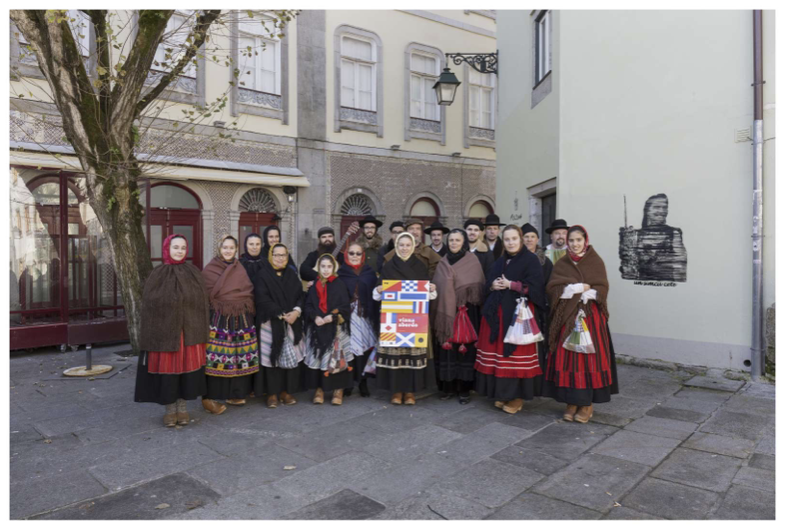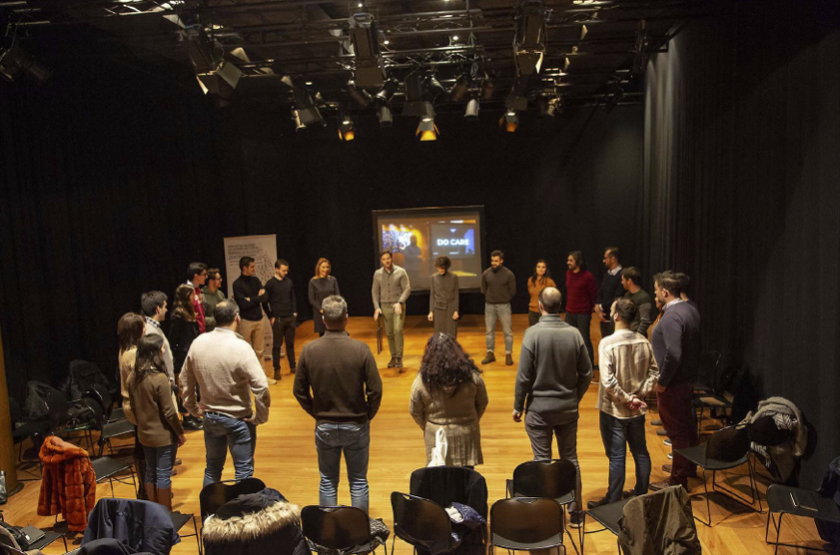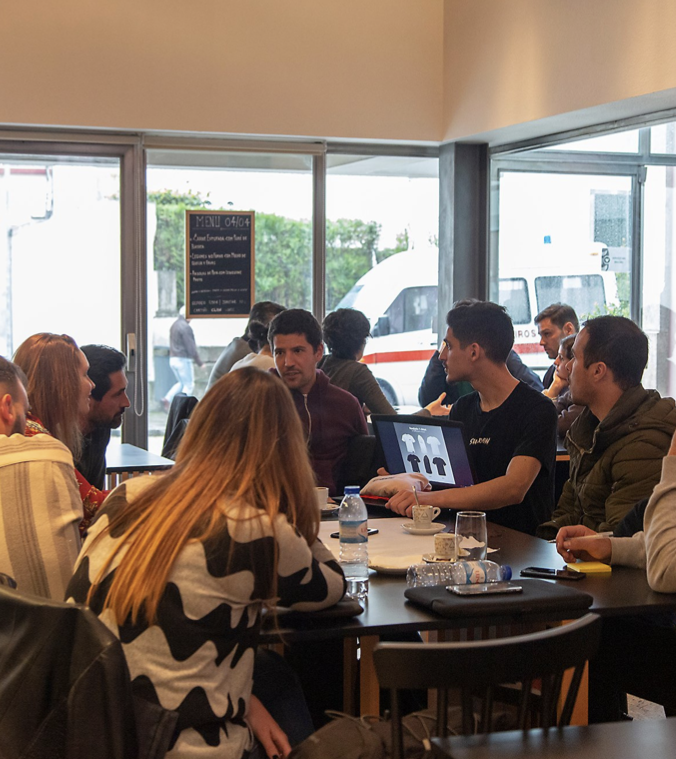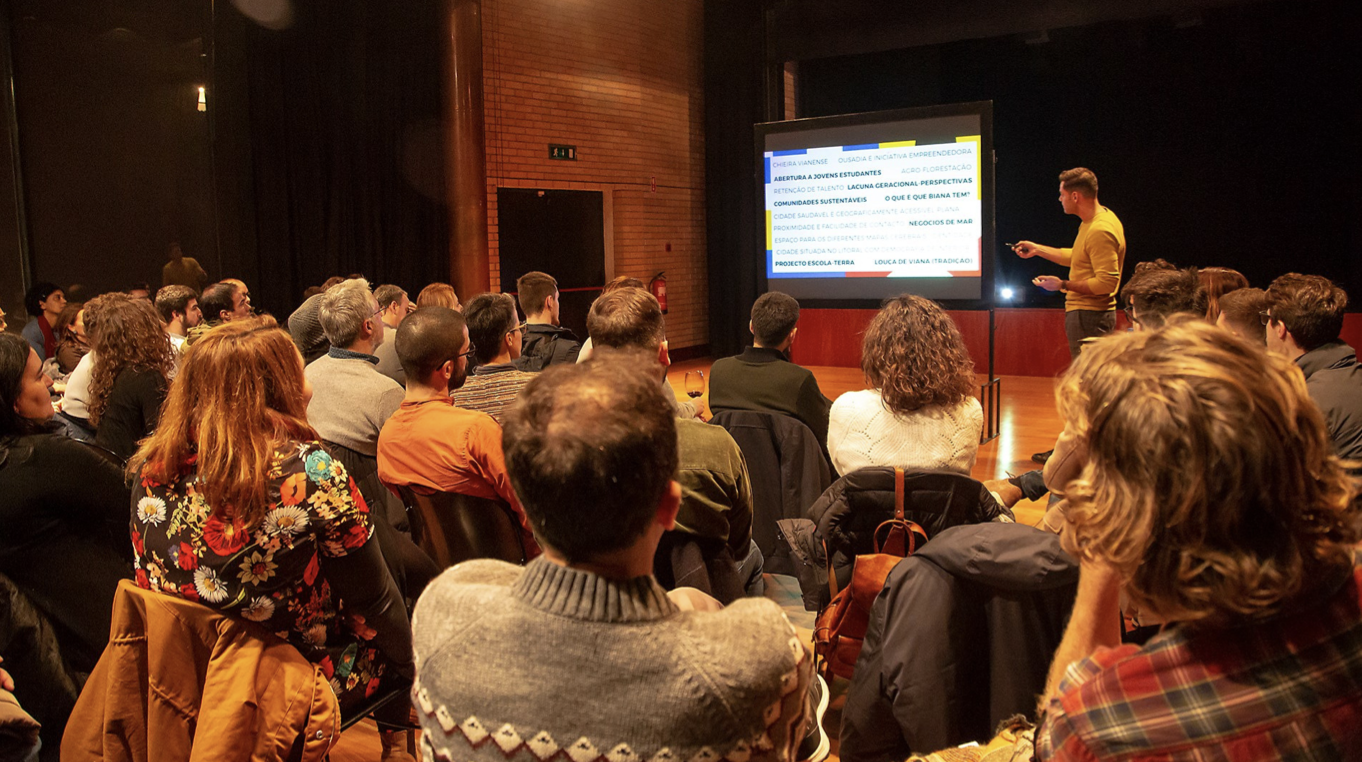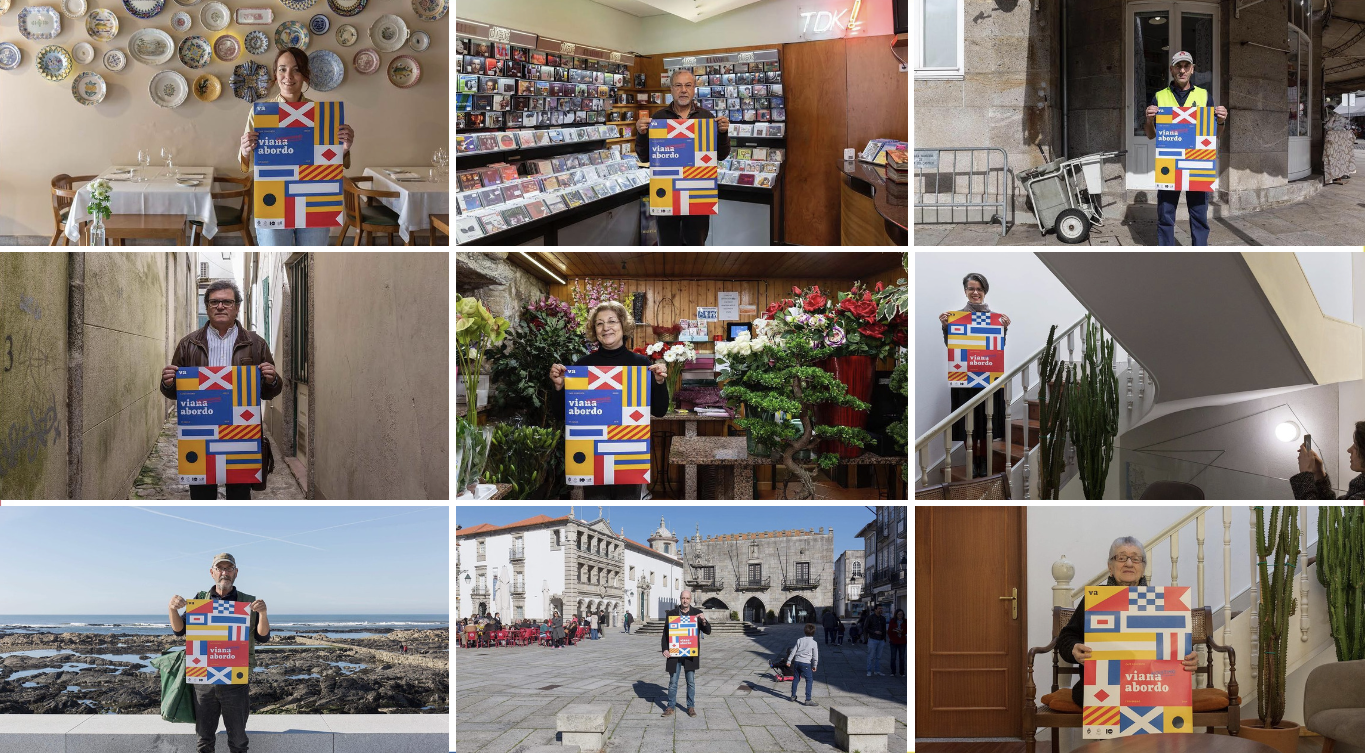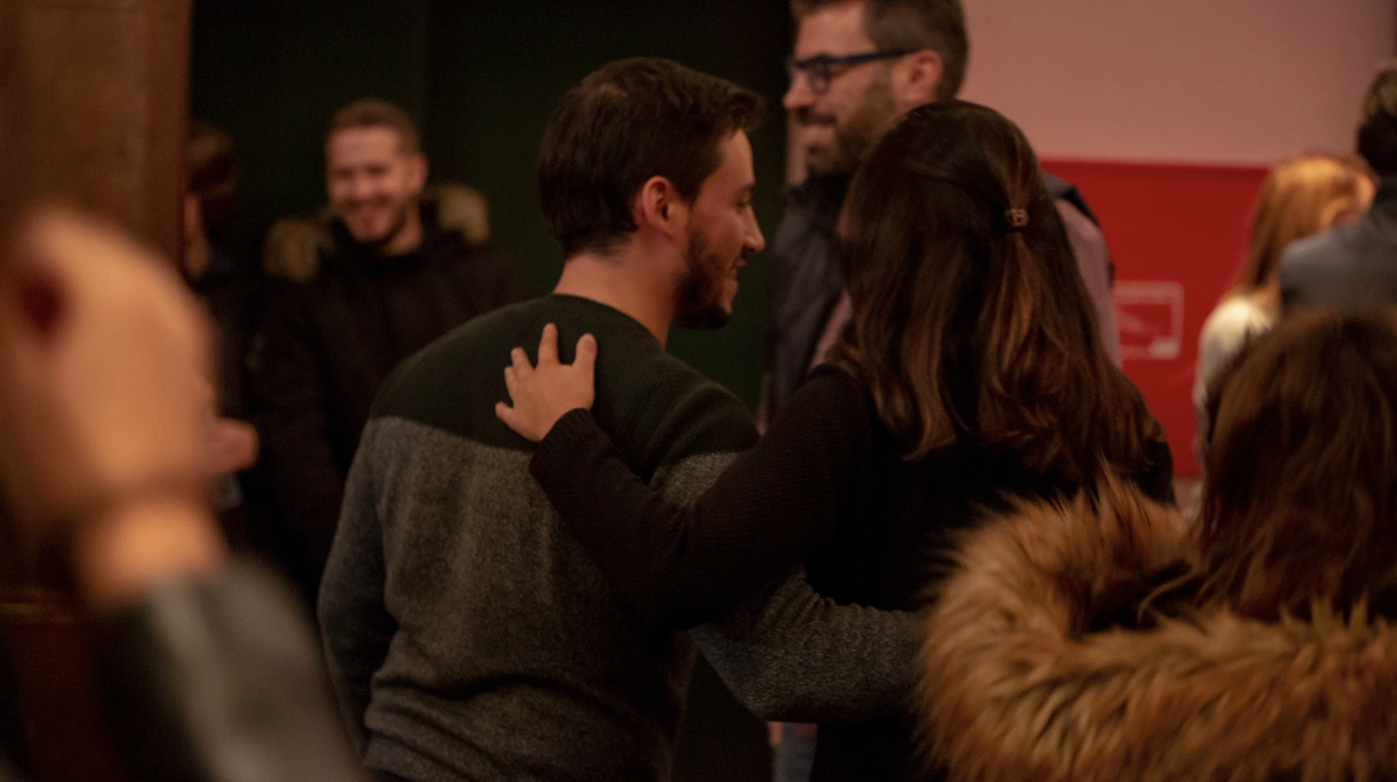Regaining a sense of belonging
Viana Abordo
Viana Abordo - shared learning and collective intelligence for local development
Viana Abordo is project created by Dinamo10 in partnership with the City Hall of Viana do Castelo to promote attraction/ retention of young talent through connection between urban and rural contexts and interaction between economic sectors (from the creative industries to agriculture or the blue economy). Its regular events allow the maintenance of an ongoing conversation between civil society, local businesses and regional authorities, to identify specific needs and generate viable solutions.
Portugal
Local
Viana do Castelo
It addresses urban-rural linkages
It refers to other types of transformations (soft investment)
Yes
2024-05-23
No
No
No
As a representative of an organisation, in partnership with other organisations
Viana Abordo focused in promoting the attraction/ retention of young talent, connection between urban and rural contexts and interaction between economic sectors (from the creative industries to agriculture or the blue economy) - hence contributing to reignite the sense of belonging in the low density district of Viana do Castelo.
It did so by promoting debate around different local challenges, addressing them to different social agents, from students, to entrepreneurs, policymakers and civil society. Such sessions also involved the participation of field experts to inspire and inform the local audience about global opportunities and resources. Overall, an average 300 participants attended each edition of Viana Abordo.
From this successful public-private partnership between Viana do Castelo's municipality and Dinamo10 creative hub, besides providing mentorship to local entrepreneurship initiatives (namely, the support to 12 entrepreneurs), a number of interesting projects have stem - all proving the relevance of Viana Abordo's approach. The first of these being the spin-off program Rural Hub, also created by Dinamo10, which takes on methodologies similar to those already developed and tested within Viana Abordo, now applied to the neighboring rural territories in the region. Another example, is the successful S+T+Arts centre now being developed in Viana do Castelo by the city hall and Dinamo10, among other partners. Last but not least, the rural hubs community Creative Habitat, under development with the support of the European Commission (Creative Europe program), composed by Dinamo10, Espacio Arroelo, Sende and Anceu co-livings (all in Galicia, Spain), and also Treballu (Sardinia, Italy), which aims to consolidate, expand and replicate their innovative and effective collaboration models of working in low density territories (including Viana Abordo), always focusing on talent attraction, cultural development, environmental sustainability and economic growth.
It did so by promoting debate around different local challenges, addressing them to different social agents, from students, to entrepreneurs, policymakers and civil society. Such sessions also involved the participation of field experts to inspire and inform the local audience about global opportunities and resources. Overall, an average 300 participants attended each edition of Viana Abordo.
From this successful public-private partnership between Viana do Castelo's municipality and Dinamo10 creative hub, besides providing mentorship to local entrepreneurship initiatives (namely, the support to 12 entrepreneurs), a number of interesting projects have stem - all proving the relevance of Viana Abordo's approach. The first of these being the spin-off program Rural Hub, also created by Dinamo10, which takes on methodologies similar to those already developed and tested within Viana Abordo, now applied to the neighboring rural territories in the region. Another example, is the successful S+T+Arts centre now being developed in Viana do Castelo by the city hall and Dinamo10, among other partners. Last but not least, the rural hubs community Creative Habitat, under development with the support of the European Commission (Creative Europe program), composed by Dinamo10, Espacio Arroelo, Sende and Anceu co-livings (all in Galicia, Spain), and also Treballu (Sardinia, Italy), which aims to consolidate, expand and replicate their innovative and effective collaboration models of working in low density territories (including Viana Abordo), always focusing on talent attraction, cultural development, environmental sustainability and economic growth.
Talent attraction and retention
The sea as resource
Bio-region/ Eco-territory
Citizen Science
Digital Communities and Inclusion
Viana Abordo's key objectives in terms of sustainability were: 1. raising awareness about Viana do Castelo's major endogenous challenges and wealth; 2. promoting knowledge and proximity among local organizations and communities; 3. promoting the development of projects and initiatives in the long run, to reinforce local economy and social and cultural cohesion.
After two editions of the initiative, we are proud to say we have successfully attained all goals: through a carefully curated program that directly responded to the requests of local citizens and institutions - addressing issues as wide and relevant as marine wealth, talent attraction and retention, marketing strategy, culture and creativity, entrepreneurship, digital inclusion, bio-regional development, citizen science or sustainable mobility, among other (1.); through a carefully designed communication strategy (see attached files) and the promotion of an open innovation model that allowed the participation and visibility of all participants (2.); and through the initiation of relevant projects for the city - directly involving Dinamo10 much because of the capacity and expertise demonstrated with Viana Abordo - namely Viana STARTS Center (https://vianastarts.pt) and CRAB - creative habitat (https://culture.ec.europa.eu/creative-europe/projects/search/details/101173600). This clearly proves the relevance and excellence of the innovative model of Viana Abordo, as an effective instrument for sustainable local and regional development, with a global (specially European) vision.
After two editions of the initiative, we are proud to say we have successfully attained all goals: through a carefully curated program that directly responded to the requests of local citizens and institutions - addressing issues as wide and relevant as marine wealth, talent attraction and retention, marketing strategy, culture and creativity, entrepreneurship, digital inclusion, bio-regional development, citizen science or sustainable mobility, among other (1.); through a carefully designed communication strategy (see attached files) and the promotion of an open innovation model that allowed the participation and visibility of all participants (2.); and through the initiation of relevant projects for the city - directly involving Dinamo10 much because of the capacity and expertise demonstrated with Viana Abordo - namely Viana STARTS Center (https://vianastarts.pt) and CRAB - creative habitat (https://culture.ec.europa.eu/creative-europe/projects/search/details/101173600). This clearly proves the relevance and excellence of the innovative model of Viana Abordo, as an effective instrument for sustainable local and regional development, with a global (specially European) vision.
Having Dinamo10 as one of the leading partners in this initiative has made a huge difference in terms of the aesthetic experience for all stakeholders involved. Dinamo10 is a creative hub (member of the European Creative Hubs Network), dedicated to promote and support the work of cultural and creative entrepreneurs in Viana do Castelo and the North of Portugal. Closely collaborating with other creative hubs and innovation institutions such as UPTEC (Porto), the Viana do Castelo Polytechnic School or CIM Alto Minho (a network of Minho's regions municipalities), Dinamo10 has been a reference not only in the creative industries sector but also in the entrepreneurship and innovation spheres in general. Its founder, Joana Carvalho, has an acute sense of curatorship, selecting and supporting projects that are not only economically viable but also aesthetically innovative and contemporary. This sense of excellence has of course contaminated Viana Abordo's identity, not only in visual terms (from the design of its promotional materials to the resulting video and photos, presentations and other contents) but also in terms of the curatorship of guest speakers and mentors who collaborate with the program. Examples such as Barbara Statcher (European Commission), Yoan Stevens (Sanitop), Africa Rodriguez (Espacio Arroelo), Edo (Sende Co-living), Fátima São Simão (cultural economist) or Marc Navarro (coworking expert), among other, clearly show the diversity of topics and approaches presented at Viana Abordo.
On the other hand, the possibility of delivering the sessions in iconic spaces belonging to the municipality of Viana (such as the municipal theatre or local museums and heritage sights) make the entire experience much more inspiring and memorable to all the local participants involved, promoting a sense of belonging which would be otherwise impossible.
On the other hand, the possibility of delivering the sessions in iconic spaces belonging to the municipality of Viana (such as the municipal theatre or local museums and heritage sights) make the entire experience much more inspiring and memorable to all the local participants involved, promoting a sense of belonging which would be otherwise impossible.
One of Viana Abordo's main concerns from the very beginning was that the project had to be accessible to virtually all of Viana do Castelo's citizens. Therefore, the program has been totally funded by the city hall, both through direct coverage of essential costs and by providing the necessary resources for the implementation of activities (namely venues and equipment). This has made it possible to offer the sessions for free to local participants and also to guarantee that, in most cases, these sessions took place in spaces prepared to receive people with special needs (namely physically impaired people). The participation of the city hall as a main partner has also made possible a more expanded communication, reaching schools, care homes and civil society organization that would otherwise be excluded from such relevant conversations. Examples of this is the session that took place at the secondary school Santa Maria Maior or the participation of civil society organizations such as AISCA (association for social, cultural and artistic intervention of Viana do Castelo). The topic of inclusion was also repeatedly addressed by the expert keynotes: not only the the curatorial team had this in mind when choosing them but also by expressively including the topic in the sessions (namely, Coasting session, on 6 June 2019, and Digital Communities and Inclusion session, on the 21st March 2024).
With 280 participants in the first edition and 350 in the second, the main impact of Viana Abordo has been the effective engagement of citizens - particularly entrepreneurs but also local administration and civil society organizations and individuals - in developing innovative solutions for the city. Inspired and supported by the interesting network of experts, participants had the chance to directly interact with them, not only during the conferences but in subsequent collective or individual mentoring sessions, where experts shared their visions and proposed strategies for the development of their entrepreneurial projects. Projects such as Atelier Entropico (activities for kids), Bipolar (design studio), Mai'land Guitars (cork made guitars) are some of the examples of the projects that started their activity with the support of Viana Abordo program and continued their activities to this day, eventually developing other projects and joint activities with Viana do Castelo and other Minho region's municipalities as well as European structures. The initiative was so successful at urban level, that it has been adapted to apply to surrounding rural towns, under the project Rural Hub, following a similar structure and open participation model (ongoing). On the other hand, the participation of experts such as Barbara Statcher, Marc Navarro or Fátima São Simão, among others, have helped raise awareness among local policymakers to the importance of the cultural and creative industries, eventually leading to the organization of the European Creative Hubs Network conference in Viana do Castelo (in 2022) and to the successful application of projects such as Viana STARTS Center (European Urban Initiative) or CRAB - Creative Habitat (Creative Europe) and other more recent consortiums to which both Dinamo10, Viana do Castelo Municipality and other local organizations have continuously been invited to join (application processes still running).
As explained, Viana Abordo results from a partnership between the Viana do Castelo's city hall and a local private creative hub, Dinamo10. While the city hall has provided access to resources and local networks, Dinamo10 has provided access to a vast and specialized network of experts and entrepreneurs in the creative and cultural industries. This has raised the interest of stakeholders and municipalities, leading them to promote the project all over Minho, allowing it to attract entrepreneurs from other parts of the region. It has also led into the development of new projects, namely the promotion of cowork spaces for public servants and private startups within CIM Alto Minho (regional network of municipalities) or the development of similar initiatives in other parts of the region (such as the Rural Hubs program). Another important level of engagement was that related to academia: through the involvement of institutions such as IPVC (Viana do Castelo Polythecnical School) or CIIMAR (Ocean Research Centre of the University of Porto), Viana Abordo was also able to attract students and researchers from all over the region, who are now actively working in projects such as Viana STARTS Center or Bem Comum, among many other. Finally, the engagement of European level agents as guest speakers has allowed to raise the standards of Viana do Castelo within the context of the creative and cultural sector, ultimately attracting new stakeholders and promoting or reinforcing of engagement in new European networks such as the STARTS initiative, European Creative Hubs Network and other.
Viana Abordo was a work in progress initiative all along the way, which involved the collaboration of creative professionals, managers, economists, policymakers and experts in entrepreneurship and innovation and other specific disciplines (mostly related to Viana do Castelo's endogenous resources, such as the sea and agriculture). Cultural and creative workers were fundamental both in contributing to create Viana Abordo concept - involving architects, designers, managers, etc, but also to the selection of its inspirational guest speakers and to the definition of its identity and discourse - mainly composed by researchers and practitioners with proved knowledge and experience in specific fields related to the territory (such as marine sciences, mobility, territorial organization, cultural studies, social inclusion, among other) but also transversal areas (such as management, innovation, marketing, economics or environment). The help of managers, engineers, economists and other specialized experts was critical not only for the rigorous implementation of the project but also to inspire and help the participating entrepreneurial projects. Finally, the active engagement of policymakers and local government has allowed for a much closer and open dialogue between all agents involved and also the development of new projects and initiatives to reinforce the regions economic development and attractiveness.
The main innovation of Viana Abordo is the actual engagement of citizens and local policymakers, through the entrepreneurship and innovation lenses, and under a careful creative (even artistic) approach. The partnership with a creative hub as allowed to reach a community that would otherwise be impossible to reach. Tech programs and events usually alienate other professionals who feel that the activities are not for them or that they don't understand enough to participate. The communication (and aesthetic) expertise and sensitivity of cultural and creative structures such as Dinamo10 and its network of creative professionals and startups allows for a much more effective and open engagement of all stakeholders involved. Because of the careful curatorial and communication work developed by Viana Abordo and also because of the familiarity and informality of the contexts of Viana Abordo's sessions, the program allowed to reach a range of participants that would usually not participate in this kind of activities as they often feel intimidated or alienated. To that extent, we can say that Viana Abordo is a social entrepreneurship program, not because it promotes social entrepreneurship (it does not focus on one particular type of entrepreneurship) but because it actually promotes the active and open participation of all types of entrepreneurs and citizens (who eventually feel inspired to pursue a more entrepreneurial pathway as well). On the other hand, because of its informal and unpretentious environment, the program all allows for an effective dialogue between municipality and its citizens. It's an innovative and efficient model of local network activation, where everybody has something to gain.
Viana Abordo guarantees a space for the people of Viana (Vienenses) to not only co-create the future of the region but also to lead their own projects benefiting from the network that stems from Viana Abordo's own maturity. Each session is an open and shared process, where everyone is invited to take part and to give and receive important contributes. This involves an inspiring guest speaker who is invited to discuss an important topic for the region. After a short expert presentation, the debate is open and all are invited to participate and present their ideas, challenges and proposals.
Viana Abordo, also includes a mentorship program with the aim of support the development of answers to the opportunities that emerge at the sessions, specially those with a strategic potential for the city and the region (namely, those promoted by local entrepreneurs). This mentorship program involves both collective and individual mentoring sessions, delivered by experts already engaged in Viana Abordo's growing network.
In an organic and almost unexpected way, the work already developed has revealed to be and important contribute to reinforce the sense of belonging among citizens (both between its traditional local population but also among new comers), and hence cultivating a strong sense of identity, belonging and value for the region.
Viana Abordo, also includes a mentorship program with the aim of support the development of answers to the opportunities that emerge at the sessions, specially those with a strategic potential for the city and the region (namely, those promoted by local entrepreneurs). This mentorship program involves both collective and individual mentoring sessions, delivered by experts already engaged in Viana Abordo's growing network.
In an organic and almost unexpected way, the work already developed has revealed to be and important contribute to reinforce the sense of belonging among citizens (both between its traditional local population but also among new comers), and hence cultivating a strong sense of identity, belonging and value for the region.
A lot of Viana Abordo's elements can be (and are already being) replicated. Its engaging sessions and open co-creation methodologies have inspired the creation of Rural Hub program, which is being delivered in the rural contexts throughout the Minho region.
The same type of open innovation approaches have also been the essential methodology used to promote work meeting between the creative rural hubs in the region and Galicia. The goal of CRAB - Creative Habitat community (recently granted a small scale Creative Europe funding: https://culture.ec.europa.eu/creative-europe/projects/search/details/101173600) is precisely to optimize and sistematize the knowledge and information gathered in programs such as Viana Abordo, to allow other regions and creative hubs in low density territories in Europe to attract and retain new talent through developing bridges with local communities and reinforcing their sense of belonging, hence activating new initiatives and reigniting their economies.
This is also true for Viana STARTS Center initiative, where Dinamo10, as responsible for its communication front, has been working closely with Viana do Castelo Municipality, replicating and adjusting the methodology and processes developed in Viana Abordo initiative to guarantee the engagement of the local community (one of its first activities was precisely a Viana Abordo session, to present the project and its potential impacts (18th January 2024) but other spin-off programs and activities are also currently being developed. It is important also to note that Dinamo10 is responsible for the transferability toolkit of Viana STARTS project, which will inspire the implementation of similar projects in other European cities, based on the experience of Viana.
The same type of open innovation approaches have also been the essential methodology used to promote work meeting between the creative rural hubs in the region and Galicia. The goal of CRAB - Creative Habitat community (recently granted a small scale Creative Europe funding: https://culture.ec.europa.eu/creative-europe/projects/search/details/101173600) is precisely to optimize and sistematize the knowledge and information gathered in programs such as Viana Abordo, to allow other regions and creative hubs in low density territories in Europe to attract and retain new talent through developing bridges with local communities and reinforcing their sense of belonging, hence activating new initiatives and reigniting their economies.
This is also true for Viana STARTS Center initiative, where Dinamo10, as responsible for its communication front, has been working closely with Viana do Castelo Municipality, replicating and adjusting the methodology and processes developed in Viana Abordo initiative to guarantee the engagement of the local community (one of its first activities was precisely a Viana Abordo session, to present the project and its potential impacts (18th January 2024) but other spin-off programs and activities are also currently being developed. It is important also to note that Dinamo10 is responsible for the transferability toolkit of Viana STARTS project, which will inspire the implementation of similar projects in other European cities, based on the experience of Viana.
The most percent global challenge addressed by Viana Abordo is sustainability. The current economic and climate crisis urges for radically innovative and local community based answers. Projects such as Viana Abordo, that promote stakeholders dialogues while, at the same time, guarantee free direct support to the implementation of small and medium projects and initiatives are an effective way to take on our current world challenges. There is no place for universalist solutions. Local communities are part of local ecosystems and need to be directly engaged in finding solutions for their local problems, considering their culture and environmental landscapes and diversity. In a small traditional city such as Viana do Castelo, this, of course, requires addressing inclusion challenges, and the implicit need to develop trust and sense of belonging among the citizens - being them native and/ or migrants.
On this front, Viana Abordo is in itself an excellent example of the effective collaboration between a city hall and a local creative hub/ cowork space (representing a community of creative entrepreneurs and artists), which allows grassroots proposals to directly influence and contribute to regional policy making in a totally open and transparent way.
On this front, Viana Abordo is in itself an excellent example of the effective collaboration between a city hall and a local creative hub/ cowork space (representing a community of creative entrepreneurs and artists), which allows grassroots proposals to directly influence and contribute to regional policy making in a totally open and transparent way.
As said, Viana Abordo's two editions represented a total of 350 participants (2019) and 280 (2023/24). This affluence of people in itself demonstrates the pertinence of this initiative.
Both editions also involved direct support to entrepreneurs (12 in the first and 15 in the second), including 50 hours of collective mentorship in each of them.
The model has also been adapted to respond to smaller towns challenges across the district of Viana do Castelo, resulting on the creation of Rural Hub, an equivalent program designed to address rural and mountain communities in the Minho region.
The success of Viana Abordo has also led to the formalization of the partnership between Viana do Castelo and Dinamo10, both members of the consortium currently responsible for the implementation of Viana STARTS center (EUI 2024-2027).
CRAB - creative habitat, the rural and peripheral creative hubs community under development between Dinamo10 and other creative hubs in low density territories of Southern Europe, has also been influenced/ inspired by the success of Viana Abordo's initiative, this time targeting European creative hubs with common characteristics.
At the moment, Dinamo10 is also working on new applications (namely Creative Europe and Erasmus+), also resulting from the knowledge and expertise gathered throughout the past years with Viana Abordo and its following projects.
Both editions also involved direct support to entrepreneurs (12 in the first and 15 in the second), including 50 hours of collective mentorship in each of them.
The model has also been adapted to respond to smaller towns challenges across the district of Viana do Castelo, resulting on the creation of Rural Hub, an equivalent program designed to address rural and mountain communities in the Minho region.
The success of Viana Abordo has also led to the formalization of the partnership between Viana do Castelo and Dinamo10, both members of the consortium currently responsible for the implementation of Viana STARTS center (EUI 2024-2027).
CRAB - creative habitat, the rural and peripheral creative hubs community under development between Dinamo10 and other creative hubs in low density territories of Southern Europe, has also been influenced/ inspired by the success of Viana Abordo's initiative, this time targeting European creative hubs with common characteristics.
At the moment, Dinamo10 is also working on new applications (namely Creative Europe and Erasmus+), also resulting from the knowledge and expertise gathered throughout the past years with Viana Abordo and its following projects.

